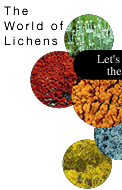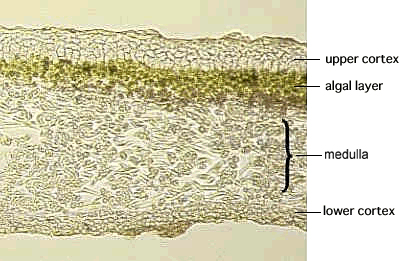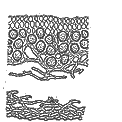

■What do they look like?
Lichens can be divided into 3 categories according to their appearances.
■Foliose lichens (e.g. Myelochroa irrugans and Flavoparmelia caperata)
(fig. 2a)
The thallus shapes like a thin sheet of paper. The upper and lower surfaces
are clearly distinct. The plant is loosely attached to a substrate by
rhizines which is located in the reverse.
■Fruticose lichens (e.g.Cladonia amaurocraea and Usnea diffracta) (fig.2b)
The thallus forms a little shrub. It stands up from a substrate or hangs
down from it.
■Crustose lichens (e.g. Buellia sp. and Lecanora cinereofusca) (fig. 2c)
The thallus is extremely thin that attaches to a substrate by hyphae in
the medulla.
The external appearance of a thallus is distinct but does not always
reflect the phylogeny of lichens although it is useful in recognizing
lichen species or genera in field studies.
■The inner structures
 |
| ●fig.3:cross-section of the thallus in foliose lichens |
The inner structure of the thallus in foliose lichens can be seen in the
above figure. The cross-section shows 4 separate layers: upper and lower
cortices on top and bottom, sandwiching algal layer and medulla in the
middle. The upper and lower cortices protect the thallus. Most of the algal
layer can be seen in the lower part of the upper cortex. The medullary
hyphae are loosely twining where most of the lichen substances are produced.
On the other hand, in case of fruticose lichens, the cross-section of
the thallus is mostly circular and cortex, algal layer and medulla line
up in a form of a concentric circle. Cortex of crustose lichens is poorly
developed. The medullary hyphae penetrate into the substrata such as rocks
and tree barks.
■Where do lichens grow?
Lichens can grow on any stable substrate from
rocks, tree barks, roofing tiles to concrete or ground surfaces. Since
it usually grow 3 mm or less in one year, it cannot survive on rolling
stones in riversides or slippery surfaces of bamboo and ice. Neither does
it grow on rocks which stay underwater all the year round.
